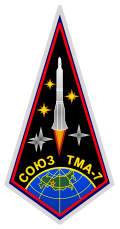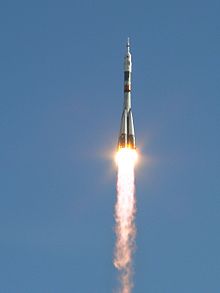Soyuz TMA-7
| Mission emblem | |||
|---|---|---|---|

|
|||
| Mission dates | |||
| Mission: | Soyuz TMA-7 | ||
| COSPAR-ID : | 2005-039A | ||
| Spacecraft: |
Soyuz 7K-STA (gray index 11F732) serial number 217 |
||
| Dimensions: | 7270 kg | ||
| Launcher: | Soyuz FG ( GRAY index 11A511FG) | ||
| Call sign: | Рассвет (Rasswet - "dawn") | ||
| Crew: | 3 | ||
| Begin: | October 1, 2005, 03:54:53 UTC | ||
| Starting place: | Baikonur 1/5 | ||
| Space station: | ISS | ||
| Coupling: | October 3, 2005, 05:26:58 UTC to the Pirs module |
||
| Decoupling: | April 8, 2006, 20:27:54 UTC from the module Zvezda |
||
| Landing: | April 8, 2006, 23:47:24 UTC | ||
| Landing place: | 54 km NE of Arkalik , 50 ° 40'N / 67 ° 21'E | ||
| Flight duration: | 189d 19h 52m 31s | ||
| Earth orbits: | 2987 | ||
| Rotation time : | 88.64 min | ||
| Apogee : | 242 km | ||
| Perigee : | 200 km | ||
| Team photo | |||
 v. l. No. Gregory Olsen, Valery Tokarev, and William S. McArthur |
|||
| ◄ Before / After ► | |||
|
|||
Soyuz TMA-7 is the mission name for the flight of a Russian Soyuz spacecraft to the International Space Station (ISS) . It is the eleventh visit of a Soyuz spacecraft to the ISS and the 117th flight in the Soyuz program.
crew
Starting crew
- Valeri Ivanovich Tokarew (2nd space flight), Commander (Roskosmos / Russia)
- William S. McArthur (4th space flight), flight engineer (NASA / USA)
- Gregory Olsen (1st space flight), space tourist (USA)
Tokarev was 52 years old at the time of launch, McArthur was 54 and Olsen was 60. With an average age of almost 56 years, this team is the oldest to have started into space.
Substitute team
- Mikhail Wladislawowitsch Tjurin , Commander (Roskosmos / Russia)
- Jeffrey Nels Williams , flight engineer (NASA / USA)
- Sergei Kostenko , space tourist
Return crew
- Valeri Ivanovich Tokarew (2nd space flight), Commander (Roskosmos / Russia)
- William S. McArthur (4th space flight), flight engineer (NASA / USA)
-
Marcos César Pontes (1st space flight), flight engineer ( Brazil )

Mission overview
This flight was a crew exchange mission to the ISS and the 28th manned flight to this station. The Expedition 11 working on the space station was replaced by the Expedition 12 crew. It consists of the Russian cosmonaut Valeri Tokarew and the American William S. McArthur . Also, the space tourist Gregory Olsen took part in the flight. He returned with Soyuz TMA-6 and the crew of Expedition 11 on 11 October 2005 paid back to Earth and for 20 million US dollars .
This flight also marks the last of the Soyuz crew transport flights, which according to the contract concluded between NASA and Roscosmos are part of Russia's obligations in the ISS project. Starting with the Soyuz TMA-7 landing, NASA has to pay for Soyuz seats should a crew member want to take off or land in a Soyuz spacecraft. However, a decree by the Bush administration since 2000 banned the purchase of high-tech products in countries that support non-nuclear states like Iran, which is the case with Russia. However, this law was relaxed in September 2005 to such an extent that NASA now has the option of paying for Russian space technology in cash.
The launch took place at a carrier rocket of the type Soyuz-FG from the Baikonur Cosmodrome on October 1, 2005 at 3:54:53 pm UTC . Nine minutes after the launch, the spacecraft separated from the third stage of the rocket, after which the solar panels were unfolded. The spacemen on board reported that all systems had worked as intended up to this point. Docking with the ISS (on the Pirs module) took place fully automatically on October 3, 2005 at 05:26:58 UTC over Central Asia. At 08:36 UTC the hatches were opened and the crew of Soyuz TMA-7 entered the space station.
On November 18, 2005 at 08:45 UTC, Soyuz TMA-7 disconnected from the Pirs docking port with space travelers Tokarev and McArthur on board and manually docked at the lower docking port of the Zarya module 20 minutes later .
On March 20, 2006 at 06:49 UTC, the Soyuz TMA-7 spacecraft with the spacemen Tokarev and McArthur on board disconnected from the lower docking nozzle of the Zarya module and manually docked 22 minutes later on the rear docking nozzle of the Zvezda module, which was previously occupied by the Progress M-54 freighter.
Further details regarding the work of the crew on the ISS are described in the article ISS Expedition 12 .
The Soyuz TMA-7 spacecraft with Tokarew, McArthur and the Brazilian Pontes launched with Soyuz TMA-8 on board disconnected from the ISS on April 8, 2006 at 20:28 UTC, and around three hours later at 23:48 UTC to land in the Kazakh steppe .
More flight dates
- Coupling ISS: October 3, 2005, 05:27 UTC (to the Pirs module)
- Decoupling ISS: November 18, 2005, 08:46 UTC (from the Pirs module)
- Coupling ISS: November 18, 2005, 09:05 UTC (to the Sarja module)
- Decoupling ISS: March 20, 2006, 06:49 UTC (from the Sarja module)
- Coupling ISS: March 20, 2006, 07:11 UTC (to the Zvezda module)
- Decoupling ISS: April 8, 2006, 20:28 UTC (from Zvezda module)
See also
- List of Soyuz missions
- List of manned space flights
- List of manned missions to the International Space Station
Web links
- Soyuz TMA-7 at spacefacts.de
- Soyuz TMA-7 on the Russian Space Web
- Soyuz TMA-7 at space.kursknet.ru (English / Russian , archived 2016)
- Soyuz TMA-7 in the Encyclopedia Astronautica (English)
- Soyuz TMA-7 in the NSSDCA Master Catalog (English)



